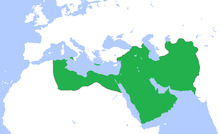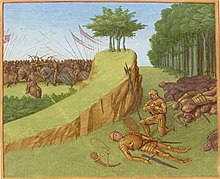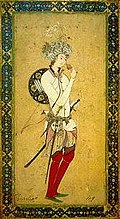Abbasid–Carolingian alliance

| Foreign alliances of France | |||||||||||||||||||||||||||||||||||||||||||||||||||||||||
|---|---|---|---|---|---|---|---|---|---|---|---|---|---|---|---|---|---|---|---|---|---|---|---|---|---|---|---|---|---|---|---|---|---|---|---|---|---|---|---|---|---|---|---|---|---|---|---|---|---|---|---|---|---|---|---|---|---|
| |||||||||||||||||||||||||||||||||||||||||||||||||||||||||
An Abbasid–Carolingian alliance was attempted during the 8th to 9th century through a series of embassies, rapprochements and combined military operations between the Frankish Carolingian Empire and the Abbasid Caliphate and pro-Abbasid rulers in Al-Andalus.[1][2][3]
The alliance is likely to have formed first between Pepin the Short and al-Mansur, and later to have continued under Charlemagne and Harun al-Rashid. These contacts followed the intense conflict between the Carolingians and the Umayyads of Al-Andalus, marked by the Battle of Tours in 732, and were aimed at establishing a counter-alliance with the 'faraway' Abbasid Empire based in the Near East. Slightly later, another Carolingian-Abbasid alliance was attempted in a conflict against the Eastern Roman Empire (Byzantine Empire).
Background[]

The Umayyad invasion of Gaul from 719 to 759 was a period of intense conflict between the Carolingians and the Umayyads, marked by the Battle of Tours in 732. Umayyad forces were finally expelled from Gaul with the conquest of Narbonne in 759 by Pepin the Short, but the Umayyad presence in the Iberian peninsula continued to represent a challenge to the Carolingians.
Contacts under Pepin the Short and al-Mansur[]
Embassies[]

Contacts between the Carolingians and the Abbasids started soon after the establishment of the Abbasid Caliphate and the concommital fall of the Umayyad Caliphate in 751. The Carolingian ruler Pepin the Short had a powerful enough position in Europe to "make his alliance valuable to the Abbasid caliph of Baghdad, al-Mansur".[4] Former supporters of the Umayyad Caliphate were established firmly in southern Spain under Abd ar-Rahman I, and constituted a strategic threat both to the Carolingians on their southern border, and to the Abbasids at the western end of their dominion.


Embassies were exchanged both ways, with the apparent objective of cooperating against the Umayyads of Spain: a Frankish embassy went to Baghdad in 765, which returned to Europe after three years with numerous presents, and an Abbasid embassy from al-Mansur visited France in 768.[4]
Commercial exchanges[]
Commercial exchanges occurred between the Carolingian and Abassid realms, and Arabic coins are known to have spread in Carolingian Europe in that period.[5] Arab gold is reported to have circulated in Europe during the 9th century, apparently in payment of the export of slaves, timber, iron and weapons from Europe to Eastern lands.[6] It is noted that Charlemagne made attempts to establish an open market between the Carolingians and Abbasids, possibly as a means for the Carolingians economically benefit from trade with the Abbasids. As a famous example, the 8th century English king Offa of Mercia is known to have minted copies of Abbasid dinars struck in 774 by Caliph Al-Mansur with "Offa Rex" centered on the reverse amid inscriptions in Pseudo-Kufic script.[7][8]
Charlemagne and Harun al-Rashid[]
Military alliance in Spain (777–778)[]
In 777, pro-Abbasid rulers of northern Spain contacted the Carolingian to request help against the powerful Umayyad Emirate of Cordoba in southern Spain, led by Abd ar-Rahman I.[9] The "Spanish Abbasids sought support for their cause in Pepin's Francia; he was content to oblige because the Cordoban dynasty posed a constant military threat to southwestern France".[10]
Sulayman al-Arabi the pro-Abbasid Wali (governor) of Barcelona and Girona sent a delegation to Charlemagne in Paderborn, offering his submission, together with the allegiance of Husayn of Zaragoza and Abu Taur of Huesca in return for military aid.[9] The three pro-Abbasid rulers also conveyed that the caliph of Baghdad, Muhammad al-Mahdi, was preparing an invasion force against the Umayyad ruler Abd al-Rhaman I.[9]

Following the sealing of this alliance at Paderborn,[11] Charlemagne marched across the Pyrenees in 778 "at the head of all the forces he could muster".[12] His troops were welcomed in Barcelona and Girona by Sulayman al-Arabi.[13] As he moved towards Zaragoza, the troops of Charlemagne were joined by troops led by Sulayman.[12] Husayn of Zaragoza, however, refused to surrender the city, claiming that he had never promised Charlemagne his allegiance. Meanwhile, the force sent by the Baghdad caliphate seems to have been stopped near Barcelona.[14] After a month of siege at Zaragoza, Charlemagne decided to return to his kingdom.[14] On his retreat, Charlemagne suffered an attack from the Basques in central Navarra. As a reprisal he attacked Pamplona, destroying it.[14] However, on his retreat north his baggage train was ambushed by the Basques at the Battle of Roncevaux Pass on August 15, 778.[15]


Left image: A coin of Charlemagne with the inscription KAROLVS IMP AVG (Karolus imperator augustus).
Right image: Persian miniature representing Harun Al-Rashid.
Strategic interest[]
Charlemagne's conflict with the Umayyad Emir of Cordova is one of the possible military conflicts which made him an ally of Harun al-Rashid,[16] as they found a common enemy to unite against.[17]
For Charlemagne, the alliance may also have functioned as a counterweight against the Byzantine Empire, which was opposed to his role in Italy and his claim to the title of Roman Emperor. For Harun al-Rashid, there was an advantage in having a partner against his rivals in Umayyad Spain.[18]
Embassies[]

After these campaigns, there were again numerous embassies between Charlemagne and the Abbasid caliph Harun al-Rashid from 797,[19] apparently in view of a Carolingian-Abbasid alliance against Byzantium,[20] or with a view to gaining an alliance against the Umayyads of Spain.[21]
Three embassies were sent by Charlemagne to Harun al-Rashid's court and the latter sent at least two embassies to Charlemagne.[20]
The 797 embassy, the first one from Charlemagne, was composed of three men, Isaac the Jew (probably as interpreter),[22] Lantfrid and Sigimud.
Four years later in 801, an Abassid embassy arrived in Pisa. They met with Charlemagne who was present in Italy at that time.[23]
In 799, Charlemagne sent another mission to the Patriarch of Jerusalem,[24] with which the Patriarch of Jerusalem sent Charlemagne the keys to the Holy Sepulcher and the site of Calvary, as well as a Jerusalem Banner.
In 802, a second embassy was sent by Charlemagne, which returned in 806.[25]
In 807, Rodbertus, Charlemagne's ambassador died as he returned from Persia. In turn, Abdallah, Harun al-Rashid's envoy reached Charlemagne in Aachen accompanied by two monks from Jerusalem, George and Felix, who represented of the Patriarch Thomas.[23]
The third and final embassy was sent by Charlemagne in 809, but it arrived after Harun al-Rashid had died.[20] The embassy returned in 813 with messages of friendship, but little concrete results.[25]
Diplomatic Gifts[]
The embassies sent by Charlemagne possessed sundry royal red fabrics, a textile noted to be of value within the Abbasid realm. In addition, Charlemagne sponsored the construction of the Church of St. Mary in Jerusalem and its library and sent sums of money with all of his envoys.[26][27]
Harun al-Rashid is reported to have sent numerous presents to Charlemagne, including silks, a brass candelabra, perfume, balsam, a tent with multi-colored curtains, ivory chessmen, and an elephant named Abul al-Abbas. The 802 Royal Frankish Annals briefly describes the arrival of the emissary referred to as Isaac the Jew, who brought with him the elephant Abul al-Abbas.[28] Abul al-Abbas is reported to have died suddenly in 810, while Charlemagne was on campaign in a town called "Lippeham".[29]
The automatic water-clock made of brass, described in the 807 Royal Frankish Annals, and had spherical decorations which would strike cymbals below to create a chiming sound for each hour. There were also twelve figurines of horsemen that would animate at the end of each hour.[30][31][32] Harun al-Rashid is also reported to have offered the custody of the Holy places in Jerusalem to Charlemagne.[20]
Artistic influences[]
Various Islamic influences seem to appear in Christian religious architecture such as the multi-colored tile designs which may have been inspired by Islamic polychromy in the 800 CE gatehouse at Lorsch Abbey.[33]
Early Carolingian architecture generally combines Roman, Early Christian, Byzantine, Islamic and Northern European designs.[34]

The “Iconoclasm” that occurred in the Byzantine Empire from 732 to 842, influenced a Christian movement that destroyed idols, icons, amongst other images. Arnold Toynbee has postulated that the successes of the Islamic Military throughout the 8th centuries motivated Byzantine Christians to adopt the notion of Islam that does not favor the imagery of idols. Charlemagne has been recorded as following the iconoclastic fervor of the East Roman Emperor Leo Syrus, however, Charlemagne's attempts were ultimately stopped by Pope Adrian I.[35]
Carolingian architecture[]


Right image: Horseshoe arches in the Palatine Chapel in Aachen.
From Carolingian times, various Islamic influences seem to appear in Christian religious architecture such as the multi-colored tile designs which may have been inspired by Islamic polychromy in the 800 CE gatehouse at Lorsch Abbey.[36]
Horseshoe arches, as well as the centralized plan, found in Carolingian churches such as Germigny-des-Prés suggest influence from the Mozarabic architectural designs of Islamic Spain.[37] Early Carolingian architecture generally combines Roman, Byzantineand Arabs Northern European designs.[37]
Lasting impacts[]
It seems that in 831, Harun al-Rashid's son al-Ma'mun also sent an embassy to Louis the Pious.[38] These embassies also seem to have had the objective of promoting commerce between the two realms.[38]
After 814 and the accession of Louis the Pious to the throne, internal dissensions prevented the Carolingians from further ventures into Spain.[21]
Almost a century later Bertha, daughter of Lothar II and mother of several tenth-century Italian kings, is reported to have sent an embassy to the Abbasid caliph Al-Muktafi, requesting friendship and a marital alliance.[39]
See also[]
Notes[]
- ^ Heck, p.172
- ^ Shalem, p.94-95
- ^ Carolingian Chronicles by Bernhard Walter Scholz, p.16
- ^ Jump up to: a b Deanesly, p.294
- ^ Goody, p.80
- ^ Charlemagne, Muhammad, and the Arab roots of capitalism by Gene W. Heck p.179-181 [1]
- ^ British Museum
- ^ Medieval European Coinage By Philip Grierson p.330
- ^ Jump up to: a b c Lewis, p.244
- ^ Mohammed, Charlemagne, and the Origins of Europe Richard Hodges, p.120 [2]
- ^ Lewis, p.245
- ^ Jump up to: a b Lewis, p.246
- ^ Lewis, p.253
- ^ Jump up to: a b c Lewis, p.249
- ^ Lewis, p.251-267
- ^ Carolingian Chronicles by Bernhard Walter Scholz p.16
- ^ Beyond the Arab disease by Riad Nourallah p.51
- ^ Creating East and West by Nancy Bisaha p.207
- ^ Heck, p. 172
- ^ Jump up to: a b c d Heck, p. 172
- ^ Jump up to: a b O'Callaghan, p.106
- ^ Charlemagne and the Early Middle Ages by Miriam Greenblatt, p.29
- ^ Jump up to: a b Gil, p.286
- ^ War And Peace in the Law of Islam by Majid Khadduri, p.247
- ^ Jump up to: a b Mohammed, Charlemagne, and the Origins of Europe Richard Hodges, p.121 [3]
- ^ Constantine VII Porphyrogenitus, Emperor of the East, 905-959. (2008). De administrando imperio. Dumbarton Oaks Center for Byzantine Studies. ISBN 978-0-88402-343-2. OCLC 1062030419.CS1 maint: multiple names: authors list (link)
- ^ Muratori, Lodovico Antonio (1762). Dall'anno 601 dell'era volgare fino all'anno 840. Olzati. OCLC 258143787.
- ^ Annales regni Francorum Anno 810 (Kurze 1895, p. 131, Monumenta Germaniae Historica edition)
- ^ Scholz 1970, pp. 91 (Eng. tr. of ARB = Royal Frankish Annals)
- ^ Daily life in the age of Charlemagne by John J. Butt p.146
- ^ Legends of Charlemagne; or Romance of the middle ages Thomas Bulfinch p. xix [4]
- ^ Scholz, Bernhard Walther (1931- ). Rogers, Barbara (1945- ). Nithardus (ca 790-ca 845). Histories (ang.) (2000). Carolingian chronicles : Royal Frankish annals and Nithard's Histories. University of Michigan Press. ISBN 0-472-06186-0. OCLC 867938000.CS1 maint: multiple names: authors list (link)
- ^ A world history of architecture Marian Moffett p.194
- ^ A world history of architecture Marian Moffett p.195
- ^ A Study of History: Abridgement of volumes VII-X by Arnold Joseph Toynbee p.259 [5]
- ^ A world history of architecture Marian Moffett p.194
- ^ Jump up to: a b A world history of architecture Marian Moffett p.195
- ^ Jump up to: a b Heck, p. 173
- ^ M. Hamidullah, "An Embassy of Queen Bertha to Caliph al-Muktafi billah in Baghdad 293/906", Journal of the Pakistan Historical Society, I, 1953, pp 272-300.
References[]
- Margaret Deanesly A History of Early Medieval Europe Taylor & Francis, London Methuen & Co, Ltd
- David Levering Lewis God's Crucible Islam and the Making of Europe, 570-1215 W.W. Norton, 2008 ISBN 978-0-393-06472-8
- Gene W. Heck When worlds collide: exploring the ideological and political foundations of the clash of civilizations Rowman & Littlefield, 2007 ISBN 0-7425-5856-8
- Jack Goody Islam in Europe, Polity Press, 2004, ISBN 978-0-7456-3193-6
- Joseph F. O'Callaghan A History of Medieval Spain Cornell University Press, 1983 ISBN 0-8014-9264-5
- Gil, Moshe (1997) [1983]. A History of Palestine, 634–1099. Translated by Ethel Broido. Cambridge: Cambridge University Press. ISBN 0-521-59984-9.
- Constantine VII Prophyrogentius, Emperor of the East. De Administrando Imperio, pp. 905–959. Dumbarton Oaks Center for Byzantine Studies, 2008. ISBN 978-0-88402-343-2.
- Scholz, Bernhard Walther (1931- ). Rogers, Barbara (1945- ). Nithardus (ca 790-ca 845). Histories (ang.) (2000). Carolingian chronicles : Royal Frankish annals and Nithard's Histories. University of Michigan Press. ISBN 0-472-06186-0. OCLC 867938000
- Kennedy, H. (1986). The early Abbasid Caliphate a political history. London: Croom Helm. OCLC 0709900929
- Muratori, Lodovico Antonio (1762). Dell'anno 601 dell'era volgare fino all'anno 840, pp. 465. Olzati. OCLC 258143787.
- Kurze, Friedrich, ed. (1895). Annales regni Francorum (741–829) qui dicuntur Annales Laurissenses maiores et Einhardi. Post editionem G. H. Pertzii. Hannover: Scriptores rerum germanicarum in usum scholarum. pp. 116–117.
- Scholz, Bernhard Walter (1970). Carolingian Chronicles: Royal Frankish Annals and Nithard's Histories. Ann Arbor: University of Michigan Press. pp. 81–2. ISBN 9780472061860. LCCN 77083456.
- Foreign relations of the Abbasid Caliphate
- 8th-century military alliances
- 9th-century military alliances
- Charlemagne
- Harun al-Rashid
- Military alliances involving France
- Military history of Al-Andalus
- Military history of the Abbasid Caliphate
- 8th century in Al-Andalus
- 9th century in Al-Andalus
- 8th century in Francia
- Military history of the Carolingian Empire
- 8th century in the Abbasid Caliphate
- 9th century in the Abbasid Caliphate
- Foreign relations of the Carolingian Empire